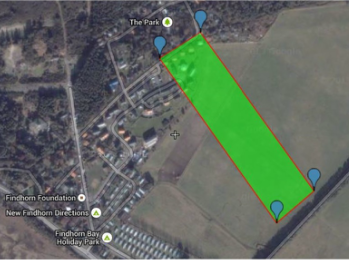case study: Land Use Feasibility
The environmental credentials of biomass rely heavily on the successful deployment of a sustainable supply chain of biomass fuel. If this cannot be achieved then the land space used will reach a level so significant that the feasibility of using biomass will be non-existent. Short rotation energy crops are more suited to the supply and demand market of biomass allowing for more harvests and an impressive yield per hectare per year. For Findhorn’s interests the willow coppice crop was studied as a potential future supply crop. With relation to the Soillse housing district (6 houses) it was studied to assess the land requirement for a sustainable supply of biomass.
The following assumptions were made for the calculations:
The following assumptions were made for the calculations:
- Willow coppice give 7 tonnes of dry mass per hectare per year.
- This occurs over a 3 year cycle; with the crops being replanted at the end of the cycle.
- Soillse continues with its average annual consumption of six 4 tonne deliveries.
- Soillse has a land footprint of 0.25 Hectares.
Figure 1. Birds eye view of the 6 houses within the Soillse Figure 2. Birds eye view of the corresponding biomass
housing district - total land use of 0.25 hectares. demand - total land use of 3.4 hectares.
housing district - total land use of 0.25 hectares. demand - total land use of 3.4 hectares.
results
The calculated results showed that there is a highly significant area required to achieve a sustainable biomass supply. For Soillse it was found that 3.4 Hectares of land would be required for a suitable supply of the coppice willow crop. It was also discovered that the land would have to undergo crop rotation roughly every 19 years. Therefore, after this period a new patch of land would need to be sought.
This land requirement is equivalent to 13.6 times that of Soillse. When put in this context it leads to questions over the long term viability of biomass; especially considering the calculations have been based on what is seen as one of the most suitable crops for biomass supply due to its high yield and growth rates.
This land requirement is equivalent to 13.6 times that of Soillse. When put in this context it leads to questions over the long term viability of biomass; especially considering the calculations have been based on what is seen as one of the most suitable crops for biomass supply due to its high yield and growth rates.


